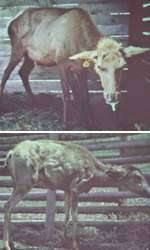By Jeff Horwich
Minnesota Public Radio
September 10, 2002
The Department of Natural Resources has begun killing deer in Aitkin County. The out-of-season hunt is unprecedented for the state, but officials have rushed it from planning to practice in less than a week. They're looking to see if chronic wasting disease (CWD) has spread beyond a single Aitkin-area elk farm. Minnesota's first case of CWD showed up on the farm when a dead elk tested positive for the disease.
| |
|
|
|
||
All this week, conservation officers will kill every deer they can inside nine square miles near Aitkin. The area surrounds the farm where an infected elk died last month. The elk might have gotten the disease from the deer, or it might have given it to them; officials just want to know as quickly as possible if it's out there at all.
Aitkin regional wildlife director Dave Schad is leading the effort. They'd like to take 50 to 100 deer. Schad expects it may take three or four weeks of hunting every weekday evening to reach that goal.
"This could be out there at a very low infection rate," Schad said. "and so the more deer we sample, the better our chance of finding it out there. If it's out there."
There may be 300 deer living in the nine square miles. Private landowners are granting permission for the DNR to shoot on their property. For this deer kill, hunters won't have to adhere to standard regulations.
| |
|
|
|
||
"Our objective here is to kill deer very efficiently and quickly, so we'll be shooting deer from vehicles, for example," Schad said. "We'll be shooting deer at night with spotlights."
Officers will take healthy, mature deer of both sexes. Chronic wasting disease causes the same symptoms in elk, deer, and mule deer: emaciation, drooping ears, dripping saliva, and hair loss. But an animal may carry and spread the disease for three years before symptoms ever appear.
The deer will have their heads removed so officials can cut an inch-long piece of the brainstem. Test results from these samples may take a few weeks. The hunt will likely be expanded if they find disease in this first round of testing.
The Aitkin deer kill follows a similar one in Wisconsin. Chronic wasting disease is known to exist in deer herds across the border.
"We certainly hope it can be stopped, and we're managing as if it were not inevitable," said Mike DonCarlos, the DNR's wildlife research manager. The deer kill has drawn a lot of attention, but officials like DonCarlos are very careful not to overstate the threat of the disease to wildlife or to people.
| |
|
|
|
||
"The public health authorities find no connection between this disease and human illness to date," said DonCarlos. "But research is underway. No one can absolutely rule out the possibility, and that's the problem. However, there's a lot of evidence to suggest it's not likely this disease would transmit to human beings."
The disease first turned up in Colorado 35 years ago, but tests have never found the disease-causing proteins in the meat of any animal. Just as a precaution, this year hunters are asked to dress their kills carefully, using gloves.
Hunters will also play a role in monitoring the disease. The DNR will take brain samples from 5,000 deer around the state in November. Hunters around Aitkin can get special licenses to allow them to take more deer than usual, possibly as many as five.
All these efforts aren't much consolation to Clayton Lueck. It was Lueck who found his elk skinny and dead on August 15 and set the whole process in motion. His herd of 48 elk still remains, grazing peacefully unaware they've been quarantined.
"Our routine is just feeding them, and that hasn't been interrupted," Lueck said. "It's all the same."
Lueck sits on the tailgate of his truck in the middle of some chores. He seems worn out by the whole thing, just waiting to be told what to do next. The elk herd was supposed to bring in some money now that he's retired. No other animals show any symptoms, but it's highly likely the U.S. Department of Agriculture will buy his herd and kill the animals for testing. In most cases like this, elk are not allowed on the land again. It looks like Lueck is out of the elk business.
"I think so," Lueck said, adding that there are still details to be worked out. "I can't say any more because we haven't heard the complete results of what they're gonna do."
Having Minnesota's first case of chronic wasting disease in his backyard hasn't made Clayton Lueck alarmist. After all, losing the herd won't change the amount of elk in his freezer. He'll keep eating the meat until someone tells him otherwise.



